Comprehensive Report: Health Governance and Management at Maori
VerifiedAdded on 2020/05/03
|17
|4257
|275
Report
AI Summary
This report provides a comprehensive overview of the health issues faced by the Maori population in New Zealand. It highlights significant inequities in healthcare access and outcomes, particularly concerning cancer, which disproportionately affects Maori. The report delves into the principles of the Treaty of Waitangi and the government's role in addressing these disparities through structural, intermediary, health, and impact-level interventions. It examines specific cancer types prevalent among Maori and emphasizes the need for government action to balance socioeconomic, gender, and geographical inequities. Furthermore, the report details recommendations for improving health outcomes, including cancer control governance, policy adjustments, and workforce enhancements, supported by a rationale and a concluding summary of the findings. The study emphasizes the necessity of addressing these issues to improve the overall health and well-being of the Maori population.

Governance and Managemenrt
Paraphrase This Document
Need a fresh take? Get an instant paraphrase of this document with our AI Paraphraser
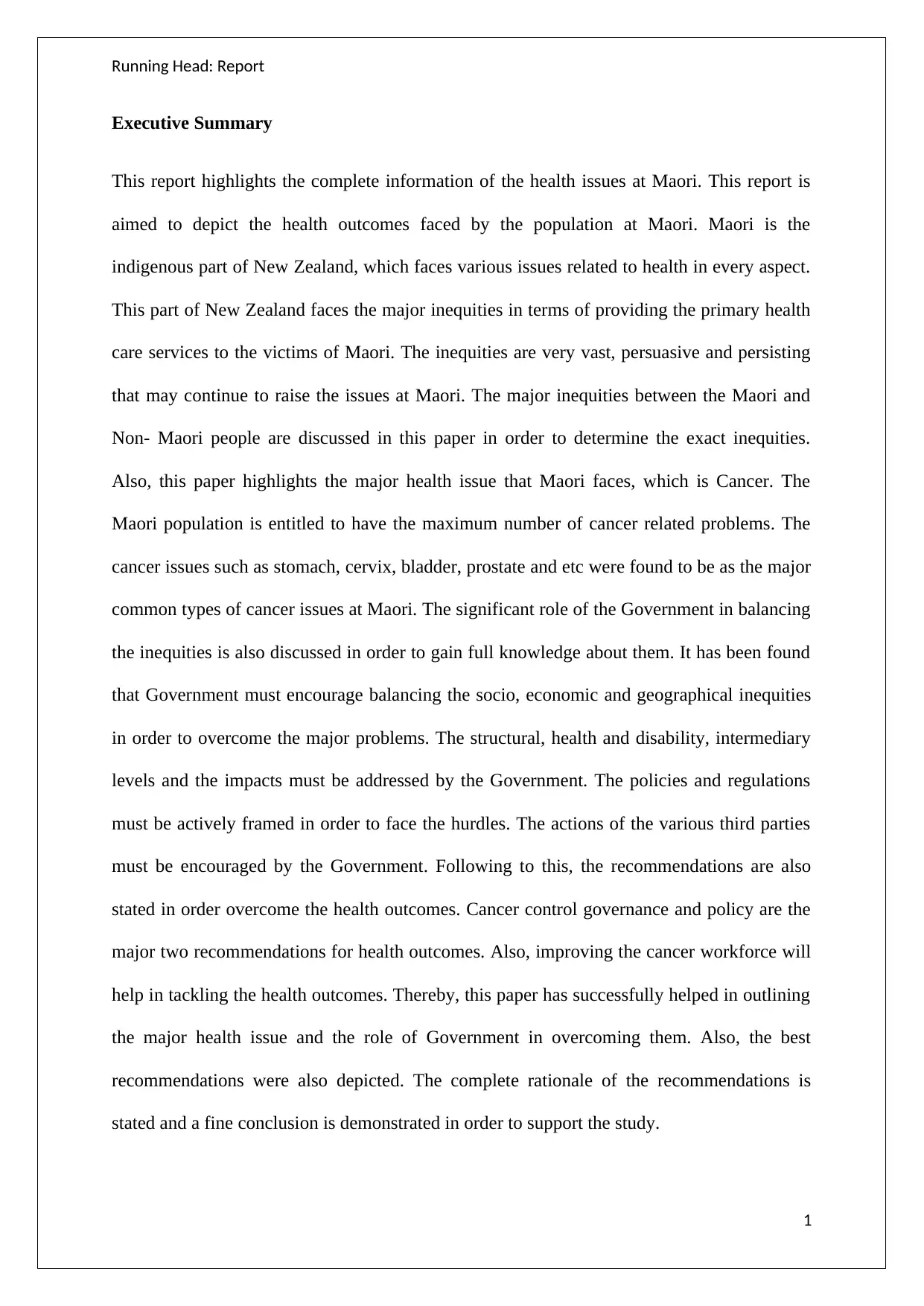
Running Head: Report
Executive Summary
This report highlights the complete information of the health issues at Maori. This report is
aimed to depict the health outcomes faced by the population at Maori. Maori is the
indigenous part of New Zealand, which faces various issues related to health in every aspect.
This part of New Zealand faces the major inequities in terms of providing the primary health
care services to the victims of Maori. The inequities are very vast, persuasive and persisting
that may continue to raise the issues at Maori. The major inequities between the Maori and
Non- Maori people are discussed in this paper in order to determine the exact inequities.
Also, this paper highlights the major health issue that Maori faces, which is Cancer. The
Maori population is entitled to have the maximum number of cancer related problems. The
cancer issues such as stomach, cervix, bladder, prostate and etc were found to be as the major
common types of cancer issues at Maori. The significant role of the Government in balancing
the inequities is also discussed in order to gain full knowledge about them. It has been found
that Government must encourage balancing the socio, economic and geographical inequities
in order to overcome the major problems. The structural, health and disability, intermediary
levels and the impacts must be addressed by the Government. The policies and regulations
must be actively framed in order to face the hurdles. The actions of the various third parties
must be encouraged by the Government. Following to this, the recommendations are also
stated in order overcome the health outcomes. Cancer control governance and policy are the
major two recommendations for health outcomes. Also, improving the cancer workforce will
help in tackling the health outcomes. Thereby, this paper has successfully helped in outlining
the major health issue and the role of Government in overcoming them. Also, the best
recommendations were also depicted. The complete rationale of the recommendations is
stated and a fine conclusion is demonstrated in order to support the study.
1
Executive Summary
This report highlights the complete information of the health issues at Maori. This report is
aimed to depict the health outcomes faced by the population at Maori. Maori is the
indigenous part of New Zealand, which faces various issues related to health in every aspect.
This part of New Zealand faces the major inequities in terms of providing the primary health
care services to the victims of Maori. The inequities are very vast, persuasive and persisting
that may continue to raise the issues at Maori. The major inequities between the Maori and
Non- Maori people are discussed in this paper in order to determine the exact inequities.
Also, this paper highlights the major health issue that Maori faces, which is Cancer. The
Maori population is entitled to have the maximum number of cancer related problems. The
cancer issues such as stomach, cervix, bladder, prostate and etc were found to be as the major
common types of cancer issues at Maori. The significant role of the Government in balancing
the inequities is also discussed in order to gain full knowledge about them. It has been found
that Government must encourage balancing the socio, economic and geographical inequities
in order to overcome the major problems. The structural, health and disability, intermediary
levels and the impacts must be addressed by the Government. The policies and regulations
must be actively framed in order to face the hurdles. The actions of the various third parties
must be encouraged by the Government. Following to this, the recommendations are also
stated in order overcome the health outcomes. Cancer control governance and policy are the
major two recommendations for health outcomes. Also, improving the cancer workforce will
help in tackling the health outcomes. Thereby, this paper has successfully helped in outlining
the major health issue and the role of Government in overcoming them. Also, the best
recommendations were also depicted. The complete rationale of the recommendations is
stated and a fine conclusion is demonstrated in order to support the study.
1
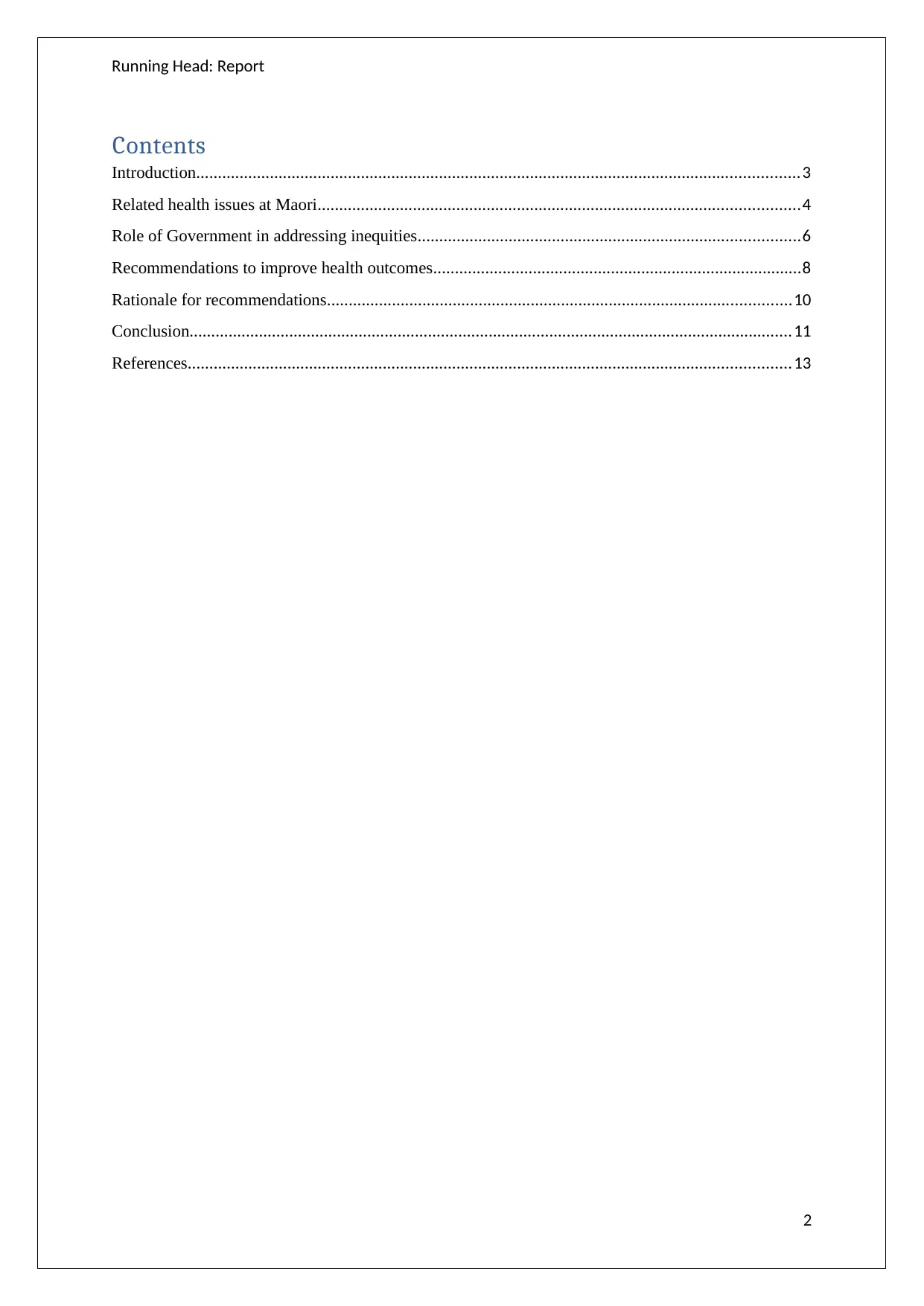
Running Head: Report
Contents
Introduction...........................................................................................................................................3
Related health issues at Maori...............................................................................................................4
Role of Government in addressing inequities........................................................................................6
Recommendations to improve health outcomes.....................................................................................8
Rationale for recommendations...........................................................................................................10
Conclusion...........................................................................................................................................11
References...........................................................................................................................................13
2
Contents
Introduction...........................................................................................................................................3
Related health issues at Maori...............................................................................................................4
Role of Government in addressing inequities........................................................................................6
Recommendations to improve health outcomes.....................................................................................8
Rationale for recommendations...........................................................................................................10
Conclusion...........................................................................................................................................11
References...........................................................................................................................................13
2
⊘ This is a preview!⊘
Do you want full access?
Subscribe today to unlock all pages.

Trusted by 1+ million students worldwide
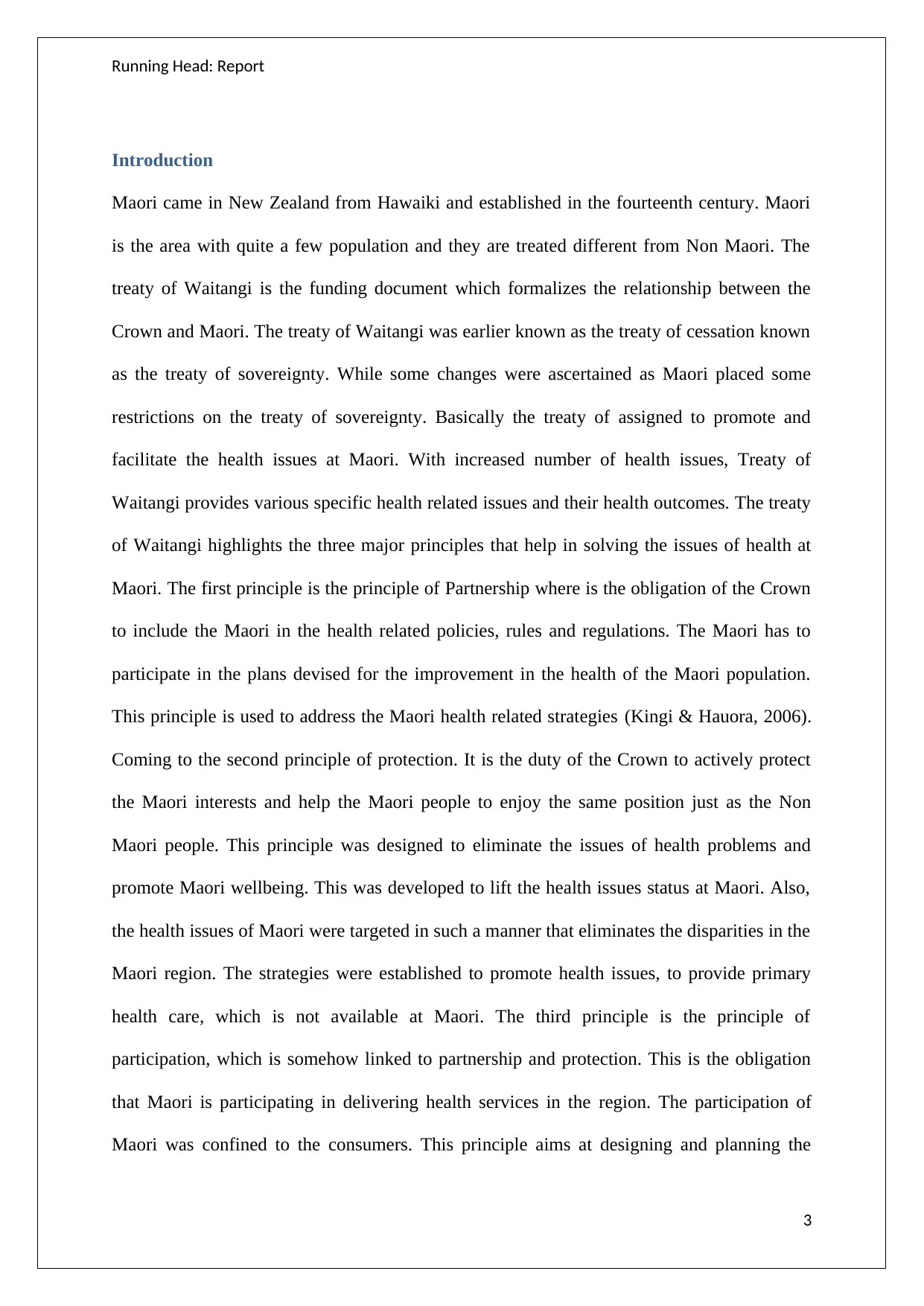
Running Head: Report
Introduction
Maori came in New Zealand from Hawaiki and established in the fourteenth century. Maori
is the area with quite a few population and they are treated different from Non Maori. The
treaty of Waitangi is the funding document which formalizes the relationship between the
Crown and Maori. The treaty of Waitangi was earlier known as the treaty of cessation known
as the treaty of sovereignty. While some changes were ascertained as Maori placed some
restrictions on the treaty of sovereignty. Basically the treaty of assigned to promote and
facilitate the health issues at Maori. With increased number of health issues, Treaty of
Waitangi provides various specific health related issues and their health outcomes. The treaty
of Waitangi highlights the three major principles that help in solving the issues of health at
Maori. The first principle is the principle of Partnership where is the obligation of the Crown
to include the Maori in the health related policies, rules and regulations. The Maori has to
participate in the plans devised for the improvement in the health of the Maori population.
This principle is used to address the Maori health related strategies (Kingi & Hauora, 2006).
Coming to the second principle of protection. It is the duty of the Crown to actively protect
the Maori interests and help the Maori people to enjoy the same position just as the Non
Maori people. This principle was designed to eliminate the issues of health problems and
promote Maori wellbeing. This was developed to lift the health issues status at Maori. Also,
the health issues of Maori were targeted in such a manner that eliminates the disparities in the
Maori region. The strategies were established to promote health issues, to provide primary
health care, which is not available at Maori. The third principle is the principle of
participation, which is somehow linked to partnership and protection. This is the obligation
that Maori is participating in delivering health services in the region. The participation of
Maori was confined to the consumers. This principle aims at designing and planning the
3
Introduction
Maori came in New Zealand from Hawaiki and established in the fourteenth century. Maori
is the area with quite a few population and they are treated different from Non Maori. The
treaty of Waitangi is the funding document which formalizes the relationship between the
Crown and Maori. The treaty of Waitangi was earlier known as the treaty of cessation known
as the treaty of sovereignty. While some changes were ascertained as Maori placed some
restrictions on the treaty of sovereignty. Basically the treaty of assigned to promote and
facilitate the health issues at Maori. With increased number of health issues, Treaty of
Waitangi provides various specific health related issues and their health outcomes. The treaty
of Waitangi highlights the three major principles that help in solving the issues of health at
Maori. The first principle is the principle of Partnership where is the obligation of the Crown
to include the Maori in the health related policies, rules and regulations. The Maori has to
participate in the plans devised for the improvement in the health of the Maori population.
This principle is used to address the Maori health related strategies (Kingi & Hauora, 2006).
Coming to the second principle of protection. It is the duty of the Crown to actively protect
the Maori interests and help the Maori people to enjoy the same position just as the Non
Maori people. This principle was designed to eliminate the issues of health problems and
promote Maori wellbeing. This was developed to lift the health issues status at Maori. Also,
the health issues of Maori were targeted in such a manner that eliminates the disparities in the
Maori region. The strategies were established to promote health issues, to provide primary
health care, which is not available at Maori. The third principle is the principle of
participation, which is somehow linked to partnership and protection. This is the obligation
that Maori is participating in delivering health services in the region. The participation of
Maori was confined to the consumers. This principle aims at designing and planning the
3
Paraphrase This Document
Need a fresh take? Get an instant paraphrase of this document with our AI Paraphraser
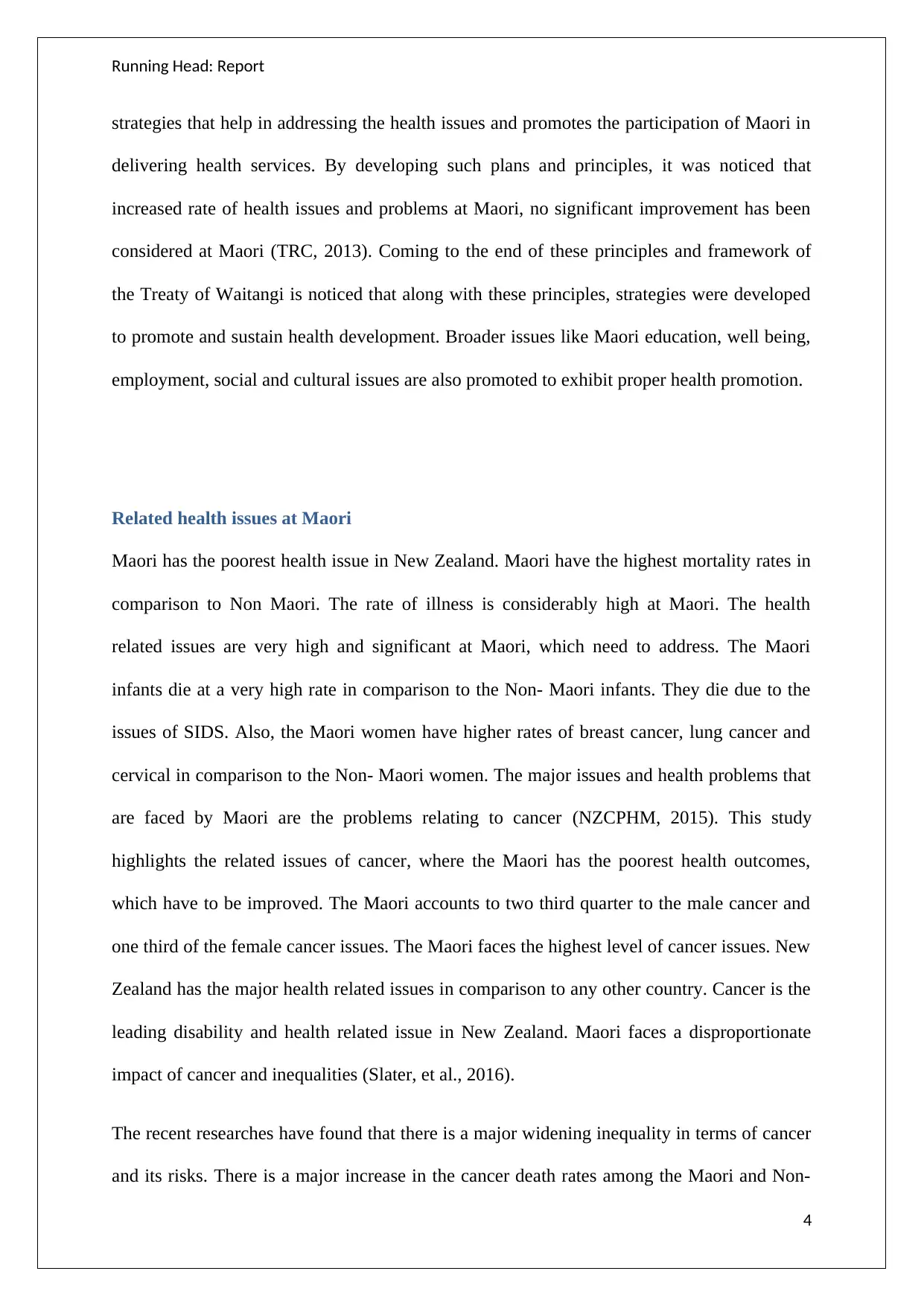
Running Head: Report
strategies that help in addressing the health issues and promotes the participation of Maori in
delivering health services. By developing such plans and principles, it was noticed that
increased rate of health issues and problems at Maori, no significant improvement has been
considered at Maori (TRC, 2013). Coming to the end of these principles and framework of
the Treaty of Waitangi is noticed that along with these principles, strategies were developed
to promote and sustain health development. Broader issues like Maori education, well being,
employment, social and cultural issues are also promoted to exhibit proper health promotion.
Related health issues at Maori
Maori has the poorest health issue in New Zealand. Maori have the highest mortality rates in
comparison to Non Maori. The rate of illness is considerably high at Maori. The health
related issues are very high and significant at Maori, which need to address. The Maori
infants die at a very high rate in comparison to the Non- Maori infants. They die due to the
issues of SIDS. Also, the Maori women have higher rates of breast cancer, lung cancer and
cervical in comparison to the Non- Maori women. The major issues and health problems that
are faced by Maori are the problems relating to cancer (NZCPHM, 2015). This study
highlights the related issues of cancer, where the Maori has the poorest health outcomes,
which have to be improved. The Maori accounts to two third quarter to the male cancer and
one third of the female cancer issues. The Maori faces the highest level of cancer issues. New
Zealand has the major health related issues in comparison to any other country. Cancer is the
leading disability and health related issue in New Zealand. Maori faces a disproportionate
impact of cancer and inequalities (Slater, et al., 2016).
The recent researches have found that there is a major widening inequality in terms of cancer
and its risks. There is a major increase in the cancer death rates among the Maori and Non-
4
strategies that help in addressing the health issues and promotes the participation of Maori in
delivering health services. By developing such plans and principles, it was noticed that
increased rate of health issues and problems at Maori, no significant improvement has been
considered at Maori (TRC, 2013). Coming to the end of these principles and framework of
the Treaty of Waitangi is noticed that along with these principles, strategies were developed
to promote and sustain health development. Broader issues like Maori education, well being,
employment, social and cultural issues are also promoted to exhibit proper health promotion.
Related health issues at Maori
Maori has the poorest health issue in New Zealand. Maori have the highest mortality rates in
comparison to Non Maori. The rate of illness is considerably high at Maori. The health
related issues are very high and significant at Maori, which need to address. The Maori
infants die at a very high rate in comparison to the Non- Maori infants. They die due to the
issues of SIDS. Also, the Maori women have higher rates of breast cancer, lung cancer and
cervical in comparison to the Non- Maori women. The major issues and health problems that
are faced by Maori are the problems relating to cancer (NZCPHM, 2015). This study
highlights the related issues of cancer, where the Maori has the poorest health outcomes,
which have to be improved. The Maori accounts to two third quarter to the male cancer and
one third of the female cancer issues. The Maori faces the highest level of cancer issues. New
Zealand has the major health related issues in comparison to any other country. Cancer is the
leading disability and health related issue in New Zealand. Maori faces a disproportionate
impact of cancer and inequalities (Slater, et al., 2016).
The recent researches have found that there is a major widening inequality in terms of cancer
and its risks. There is a major increase in the cancer death rates among the Maori and Non-
4
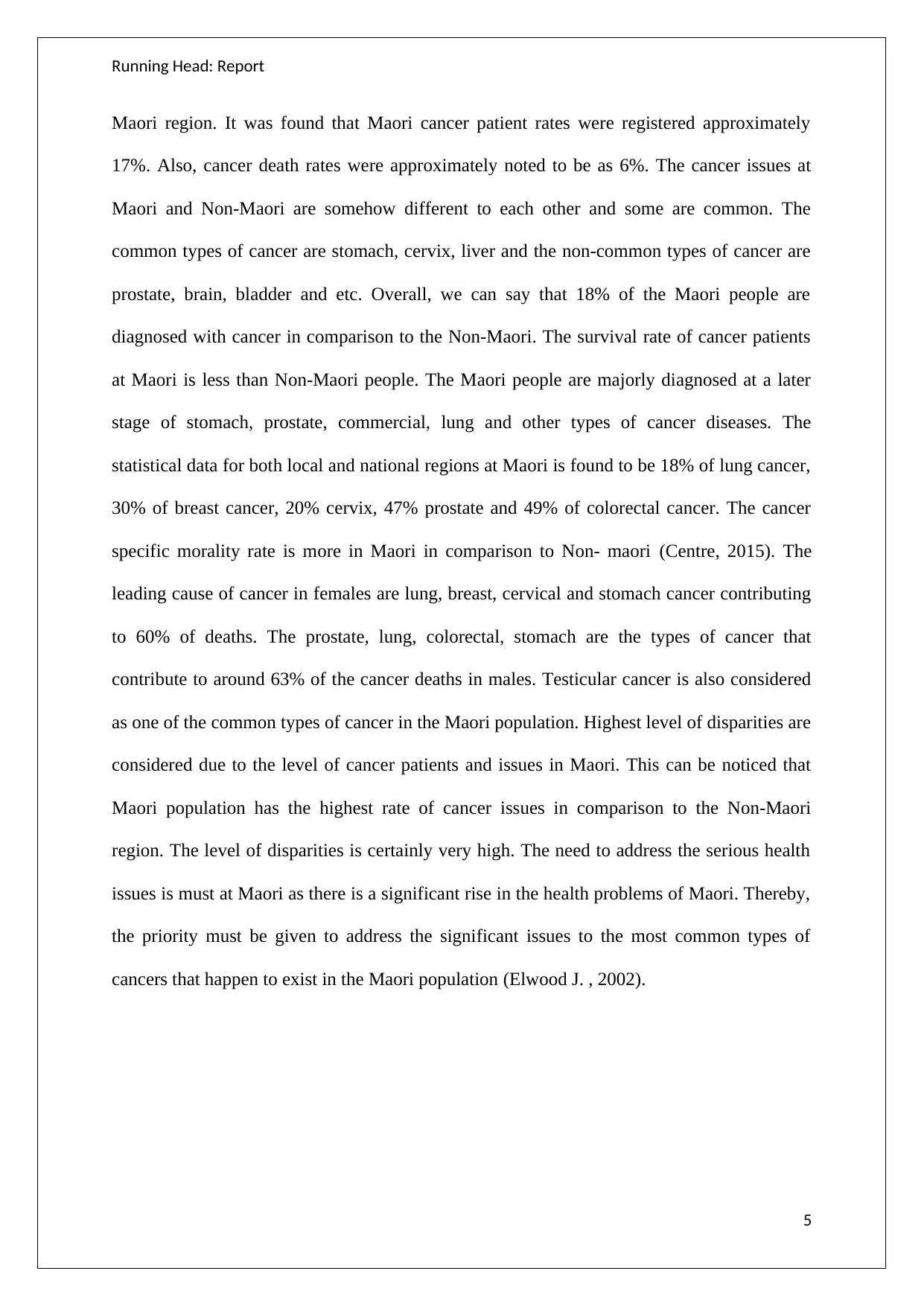
Running Head: Report
Maori region. It was found that Maori cancer patient rates were registered approximately
17%. Also, cancer death rates were approximately noted to be as 6%. The cancer issues at
Maori and Non-Maori are somehow different to each other and some are common. The
common types of cancer are stomach, cervix, liver and the non-common types of cancer are
prostate, brain, bladder and etc. Overall, we can say that 18% of the Maori people are
diagnosed with cancer in comparison to the Non-Maori. The survival rate of cancer patients
at Maori is less than Non-Maori people. The Maori people are majorly diagnosed at a later
stage of stomach, prostate, commercial, lung and other types of cancer diseases. The
statistical data for both local and national regions at Maori is found to be 18% of lung cancer,
30% of breast cancer, 20% cervix, 47% prostate and 49% of colorectal cancer. The cancer
specific morality rate is more in Maori in comparison to Non- maori (Centre, 2015). The
leading cause of cancer in females are lung, breast, cervical and stomach cancer contributing
to 60% of deaths. The prostate, lung, colorectal, stomach are the types of cancer that
contribute to around 63% of the cancer deaths in males. Testicular cancer is also considered
as one of the common types of cancer in the Maori population. Highest level of disparities are
considered due to the level of cancer patients and issues in Maori. This can be noticed that
Maori population has the highest rate of cancer issues in comparison to the Non-Maori
region. The level of disparities is certainly very high. The need to address the serious health
issues is must at Maori as there is a significant rise in the health problems of Maori. Thereby,
the priority must be given to address the significant issues to the most common types of
cancers that happen to exist in the Maori population (Elwood J. , 2002).
5
Maori region. It was found that Maori cancer patient rates were registered approximately
17%. Also, cancer death rates were approximately noted to be as 6%. The cancer issues at
Maori and Non-Maori are somehow different to each other and some are common. The
common types of cancer are stomach, cervix, liver and the non-common types of cancer are
prostate, brain, bladder and etc. Overall, we can say that 18% of the Maori people are
diagnosed with cancer in comparison to the Non-Maori. The survival rate of cancer patients
at Maori is less than Non-Maori people. The Maori people are majorly diagnosed at a later
stage of stomach, prostate, commercial, lung and other types of cancer diseases. The
statistical data for both local and national regions at Maori is found to be 18% of lung cancer,
30% of breast cancer, 20% cervix, 47% prostate and 49% of colorectal cancer. The cancer
specific morality rate is more in Maori in comparison to Non- maori (Centre, 2015). The
leading cause of cancer in females are lung, breast, cervical and stomach cancer contributing
to 60% of deaths. The prostate, lung, colorectal, stomach are the types of cancer that
contribute to around 63% of the cancer deaths in males. Testicular cancer is also considered
as one of the common types of cancer in the Maori population. Highest level of disparities are
considered due to the level of cancer patients and issues in Maori. This can be noticed that
Maori population has the highest rate of cancer issues in comparison to the Non-Maori
region. The level of disparities is certainly very high. The need to address the serious health
issues is must at Maori as there is a significant rise in the health problems of Maori. Thereby,
the priority must be given to address the significant issues to the most common types of
cancers that happen to exist in the Maori population (Elwood J. , 2002).
5
⊘ This is a preview!⊘
Do you want full access?
Subscribe today to unlock all pages.

Trusted by 1+ million students worldwide

Running Head: Report
Role of Government in addressing inequities
The increased number of inequities in the Maori can lead to differential experiences in the
health care among the population groups at Maori. The significant disparities between the
health outcomes lead to the persistent inequities in the health care of the Maori. Major
disparities in health care between the Maori and Non-Maori have been addressed. The access
to timely, quality health services is the key element and need of the population of the New
Zealand. It becomes the need of the Government to ensure such policies and regulations in
order to provide better quality and timely health care services to the Maori patients in order to
overcome the issues of inequities (Robson, 2006). The ethnic identity is the major
determinant of health inequities. The health status at Maori is very poor in comparison to the
health status of other New Zealanders. Actions by the Government must be taken in order to
address the Health inequities and also to recognize the Treaty of Waitangi obligations. Also,
there was a need for the Government to address the gender and geographical inequalities
(Hauora, 2002).
While addressing the socio, economic, gender and geographical inequities, the population
health approach has to be studied in order to identify the influence of these factors on the
health of the Maori population. This aims at identifying the influence on the health and how
can the actions be taken in order to improve the health disparities. The intersectoral action
must be used in order to address the socio economic determinants of the health. In order to
reduce the health inequities, it is very important to propose the principles that help in
incurring such activities that further reduce the level of disparities and inequities in the health
care and status (NZMA, 2011). The framework proposed by the Government was to imply
strategies at the four levels. The four levels are the structural, intermediary pathways, health
and disability services and impact. The Ministry of Health states the structural level that
6
Role of Government in addressing inequities
The increased number of inequities in the Maori can lead to differential experiences in the
health care among the population groups at Maori. The significant disparities between the
health outcomes lead to the persistent inequities in the health care of the Maori. Major
disparities in health care between the Maori and Non-Maori have been addressed. The access
to timely, quality health services is the key element and need of the population of the New
Zealand. It becomes the need of the Government to ensure such policies and regulations in
order to provide better quality and timely health care services to the Maori patients in order to
overcome the issues of inequities (Robson, 2006). The ethnic identity is the major
determinant of health inequities. The health status at Maori is very poor in comparison to the
health status of other New Zealanders. Actions by the Government must be taken in order to
address the Health inequities and also to recognize the Treaty of Waitangi obligations. Also,
there was a need for the Government to address the gender and geographical inequalities
(Hauora, 2002).
While addressing the socio, economic, gender and geographical inequities, the population
health approach has to be studied in order to identify the influence of these factors on the
health of the Maori population. This aims at identifying the influence on the health and how
can the actions be taken in order to improve the health disparities. The intersectoral action
must be used in order to address the socio economic determinants of the health. In order to
reduce the health inequities, it is very important to propose the principles that help in
incurring such activities that further reduce the level of disparities and inequities in the health
care and status (NZMA, 2011). The framework proposed by the Government was to imply
strategies at the four levels. The four levels are the structural, intermediary pathways, health
and disability services and impact. The Ministry of Health states the structural level that
6
Paraphrase This Document
Need a fresh take? Get an instant paraphrase of this document with our AI Paraphraser

Running Head: Report
tackles the root causes of health that emerge from the social, economic disparities. The labor
market policy, tax policy creates disparities in the distribution of the income, employment
and educational facilities. This is turn increase the level of problems in the health status of the
Maori people. Therefore, the government can take coorective measures in order to address
the key actions at the structural level. The intermediary pathways must be tackled in order to
impose actions on the psychological and behavioural factors that increase the level of
problems at the structural levels. The focus on subsiding the impact of the intermediary
pathways must be tackled in order to reduce the health inequities (Medical Council of New
Zealand, 2008). The Government has and can reduce the health inequities by focusing on
providing more facilities in the health and disability health care services. Specific actions
must be taken and are currently addressed by the Government in order to overcome the
ailment and inequities in the health and disability services. Also, by minimizing the impact of
illness on the socioeconomic position must be addressed. The policies and actions are such
that reduce the discrimination actions such as biasedness and stereotyping function. The
government has implie various policies and obligations to address the differential impact of
the illness on the socioeconomic position (Blakely & Dew, 2004).
Also, the Government is playing an active role in addressing the interventions at all the four
levels. The actions must be taken nationally, regionally and locally by the policy makers, care
providers and funders. This complete framework is used to address the current problems that
help in contributing to the improvement in the health care services at the Maori. The levels
when addressed help in shaping the health of the Maori population. Also, the Government
seeks to initate the participation of the outside factors such as the treasury, social welfare,
local markets and etc, to contribute significantly to the process of reducing inequities in the
health services of Maori. The Ministry of Health aims at implementing all the possible
actions and framework that has been designed also by compiling the interventions in order to
7
tackles the root causes of health that emerge from the social, economic disparities. The labor
market policy, tax policy creates disparities in the distribution of the income, employment
and educational facilities. This is turn increase the level of problems in the health status of the
Maori people. Therefore, the government can take coorective measures in order to address
the key actions at the structural level. The intermediary pathways must be tackled in order to
impose actions on the psychological and behavioural factors that increase the level of
problems at the structural levels. The focus on subsiding the impact of the intermediary
pathways must be tackled in order to reduce the health inequities (Medical Council of New
Zealand, 2008). The Government has and can reduce the health inequities by focusing on
providing more facilities in the health and disability health care services. Specific actions
must be taken and are currently addressed by the Government in order to overcome the
ailment and inequities in the health and disability services. Also, by minimizing the impact of
illness on the socioeconomic position must be addressed. The policies and actions are such
that reduce the discrimination actions such as biasedness and stereotyping function. The
government has implie various policies and obligations to address the differential impact of
the illness on the socioeconomic position (Blakely & Dew, 2004).
Also, the Government is playing an active role in addressing the interventions at all the four
levels. The actions must be taken nationally, regionally and locally by the policy makers, care
providers and funders. This complete framework is used to address the current problems that
help in contributing to the improvement in the health care services at the Maori. The levels
when addressed help in shaping the health of the Maori population. Also, the Government
seeks to initate the participation of the outside factors such as the treasury, social welfare,
local markets and etc, to contribute significantly to the process of reducing inequities in the
health services of Maori. The Ministry of Health aims at implementing all the possible
actions and framework that has been designed also by compiling the interventions in order to
7
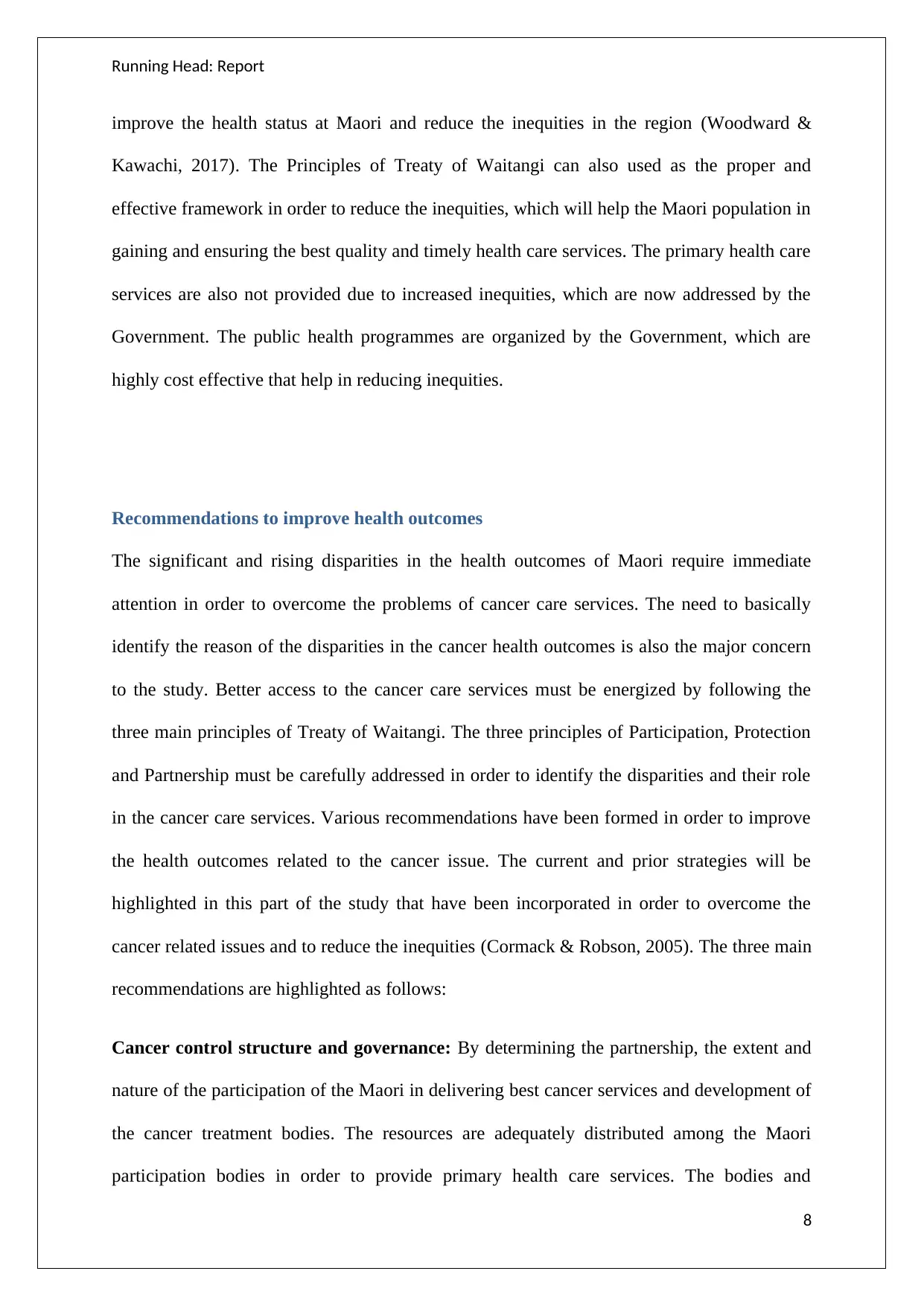
Running Head: Report
improve the health status at Maori and reduce the inequities in the region (Woodward &
Kawachi, 2017). The Principles of Treaty of Waitangi can also used as the proper and
effective framework in order to reduce the inequities, which will help the Maori population in
gaining and ensuring the best quality and timely health care services. The primary health care
services are also not provided due to increased inequities, which are now addressed by the
Government. The public health programmes are organized by the Government, which are
highly cost effective that help in reducing inequities.
Recommendations to improve health outcomes
The significant and rising disparities in the health outcomes of Maori require immediate
attention in order to overcome the problems of cancer care services. The need to basically
identify the reason of the disparities in the cancer health outcomes is also the major concern
to the study. Better access to the cancer care services must be energized by following the
three main principles of Treaty of Waitangi. The three principles of Participation, Protection
and Partnership must be carefully addressed in order to identify the disparities and their role
in the cancer care services. Various recommendations have been formed in order to improve
the health outcomes related to the cancer issue. The current and prior strategies will be
highlighted in this part of the study that have been incorporated in order to overcome the
cancer related issues and to reduce the inequities (Cormack & Robson, 2005). The three main
recommendations are highlighted as follows:
Cancer control structure and governance: By determining the partnership, the extent and
nature of the participation of the Maori in delivering best cancer services and development of
the cancer treatment bodies. The resources are adequately distributed among the Maori
participation bodies in order to provide primary health care services. The bodies and
8
improve the health status at Maori and reduce the inequities in the region (Woodward &
Kawachi, 2017). The Principles of Treaty of Waitangi can also used as the proper and
effective framework in order to reduce the inequities, which will help the Maori population in
gaining and ensuring the best quality and timely health care services. The primary health care
services are also not provided due to increased inequities, which are now addressed by the
Government. The public health programmes are organized by the Government, which are
highly cost effective that help in reducing inequities.
Recommendations to improve health outcomes
The significant and rising disparities in the health outcomes of Maori require immediate
attention in order to overcome the problems of cancer care services. The need to basically
identify the reason of the disparities in the cancer health outcomes is also the major concern
to the study. Better access to the cancer care services must be energized by following the
three main principles of Treaty of Waitangi. The three principles of Participation, Protection
and Partnership must be carefully addressed in order to identify the disparities and their role
in the cancer care services. Various recommendations have been formed in order to improve
the health outcomes related to the cancer issue. The current and prior strategies will be
highlighted in this part of the study that have been incorporated in order to overcome the
cancer related issues and to reduce the inequities (Cormack & Robson, 2005). The three main
recommendations are highlighted as follows:
Cancer control structure and governance: By determining the partnership, the extent and
nature of the participation of the Maori in delivering best cancer services and development of
the cancer treatment bodies. The resources are adequately distributed among the Maori
participation bodies in order to provide primary health care services. The bodies and
8
⊘ This is a preview!⊘
Do you want full access?
Subscribe today to unlock all pages.

Trusted by 1+ million students worldwide

Running Head: Report
structures are properly evaluated and established under proper governance in order to address
the Maori rights and reduce inequities. The proper development of the guidelines and
regulations in order to address the cancer control priorities in Maori (Sheridan, et al., 2011).
Cancer control policy: The better integration of the principles that help in building cancer
control strategies that lead to practice of reducing inequalities. This the current strategy that
help in creating dual focus that further reduces the inequities and reduces the level of cancer
in Maori. The ensurety of Maori participation in developing and funding the cancer policy.
The assessment of policy and funding decisions in order to overcome the differential effect of
various discrimination and thus, bringing a decrease in the inequities. Also, must aim at
encouraging a planned approach that helps in addressing the interventions of cancer control
services for Maori (Blakely, et al., 2010).
Cancer workforce: The comprehensive system must be build in order to increase the level of
awareness among the cancer care providers. The cancer workforce must be trained and
developed efficiently in order to address the cancer related issues in Maori. The workforce
must be developed in such a manner that provides culturally safe treatment to the cancer
patients. The funding system must be encouraged in order to motivate the cancer workforce.
Also, the support for valuable contribution must be initiated to the Maori service provider to
enhance the access to the cancer care service. Development of tools and health professionals
must be initiated in order to provide effective cancer related information to the Maori patients
(Kram, 2014).
9
structures are properly evaluated and established under proper governance in order to address
the Maori rights and reduce inequities. The proper development of the guidelines and
regulations in order to address the cancer control priorities in Maori (Sheridan, et al., 2011).
Cancer control policy: The better integration of the principles that help in building cancer
control strategies that lead to practice of reducing inequalities. This the current strategy that
help in creating dual focus that further reduces the inequities and reduces the level of cancer
in Maori. The ensurety of Maori participation in developing and funding the cancer policy.
The assessment of policy and funding decisions in order to overcome the differential effect of
various discrimination and thus, bringing a decrease in the inequities. Also, must aim at
encouraging a planned approach that helps in addressing the interventions of cancer control
services for Maori (Blakely, et al., 2010).
Cancer workforce: The comprehensive system must be build in order to increase the level of
awareness among the cancer care providers. The cancer workforce must be trained and
developed efficiently in order to address the cancer related issues in Maori. The workforce
must be developed in such a manner that provides culturally safe treatment to the cancer
patients. The funding system must be encouraged in order to motivate the cancer workforce.
Also, the support for valuable contribution must be initiated to the Maori service provider to
enhance the access to the cancer care service. Development of tools and health professionals
must be initiated in order to provide effective cancer related information to the Maori patients
(Kram, 2014).
9
Paraphrase This Document
Need a fresh take? Get an instant paraphrase of this document with our AI Paraphraser
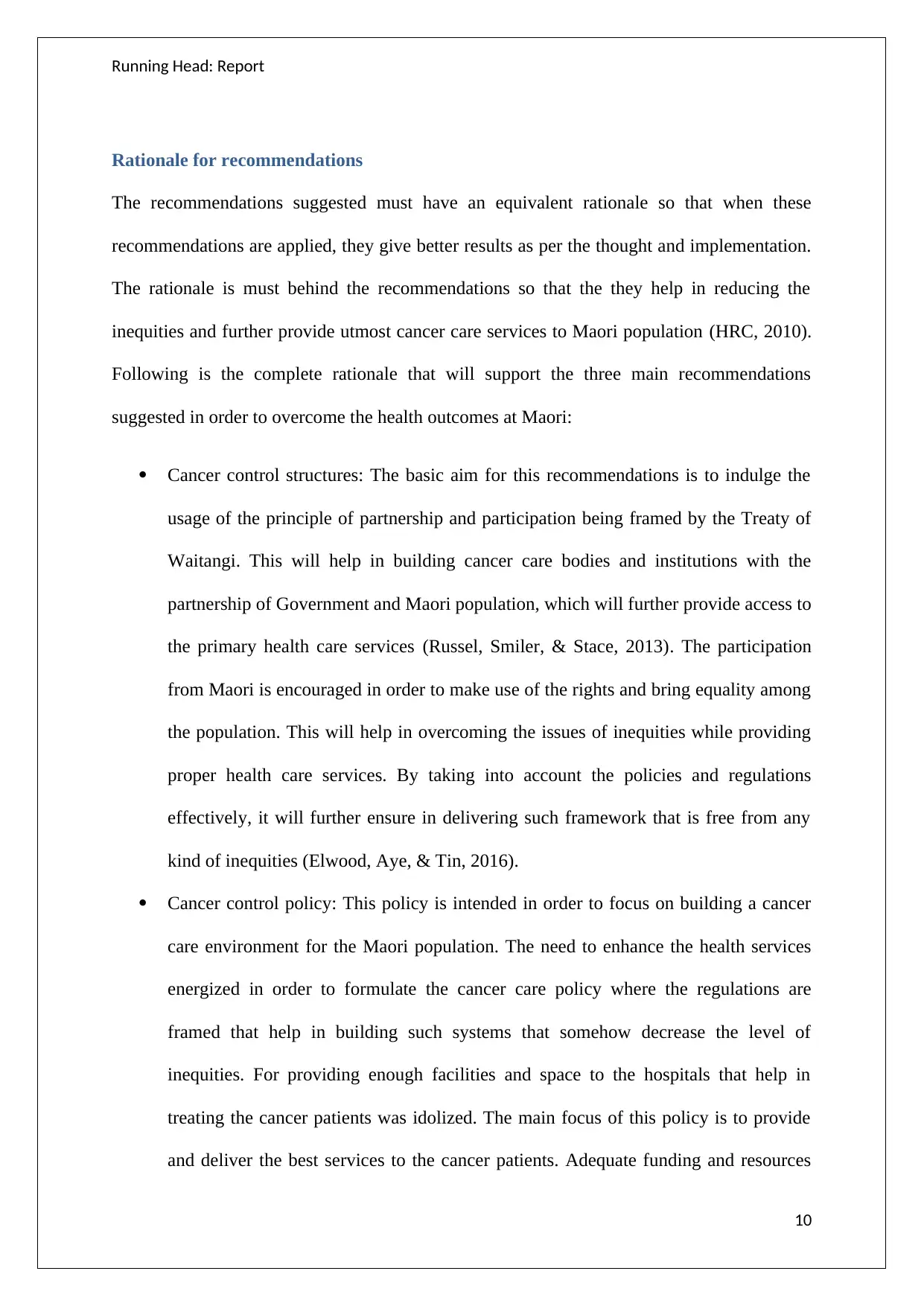
Running Head: Report
Rationale for recommendations
The recommendations suggested must have an equivalent rationale so that when these
recommendations are applied, they give better results as per the thought and implementation.
The rationale is must behind the recommendations so that the they help in reducing the
inequities and further provide utmost cancer care services to Maori population (HRC, 2010).
Following is the complete rationale that will support the three main recommendations
suggested in order to overcome the health outcomes at Maori:
Cancer control structures: The basic aim for this recommendations is to indulge the
usage of the principle of partnership and participation being framed by the Treaty of
Waitangi. This will help in building cancer care bodies and institutions with the
partnership of Government and Maori population, which will further provide access to
the primary health care services (Russel, Smiler, & Stace, 2013). The participation
from Maori is encouraged in order to make use of the rights and bring equality among
the population. This will help in overcoming the issues of inequities while providing
proper health care services. By taking into account the policies and regulations
effectively, it will further ensure in delivering such framework that is free from any
kind of inequities (Elwood, Aye, & Tin, 2016).
Cancer control policy: This policy is intended in order to focus on building a cancer
care environment for the Maori population. The need to enhance the health services
energized in order to formulate the cancer care policy where the regulations are
framed that help in building such systems that somehow decrease the level of
inequities. For providing enough facilities and space to the hospitals that help in
treating the cancer patients was idolized. The main focus of this policy is to provide
and deliver the best services to the cancer patients. Adequate funding and resources
10
Rationale for recommendations
The recommendations suggested must have an equivalent rationale so that when these
recommendations are applied, they give better results as per the thought and implementation.
The rationale is must behind the recommendations so that the they help in reducing the
inequities and further provide utmost cancer care services to Maori population (HRC, 2010).
Following is the complete rationale that will support the three main recommendations
suggested in order to overcome the health outcomes at Maori:
Cancer control structures: The basic aim for this recommendations is to indulge the
usage of the principle of partnership and participation being framed by the Treaty of
Waitangi. This will help in building cancer care bodies and institutions with the
partnership of Government and Maori population, which will further provide access to
the primary health care services (Russel, Smiler, & Stace, 2013). The participation
from Maori is encouraged in order to make use of the rights and bring equality among
the population. This will help in overcoming the issues of inequities while providing
proper health care services. By taking into account the policies and regulations
effectively, it will further ensure in delivering such framework that is free from any
kind of inequities (Elwood, Aye, & Tin, 2016).
Cancer control policy: This policy is intended in order to focus on building a cancer
care environment for the Maori population. The need to enhance the health services
energized in order to formulate the cancer care policy where the regulations are
framed that help in building such systems that somehow decrease the level of
inequities. For providing enough facilities and space to the hospitals that help in
treating the cancer patients was idolized. The main focus of this policy is to provide
and deliver the best services to the cancer patients. Adequate funding and resources
10
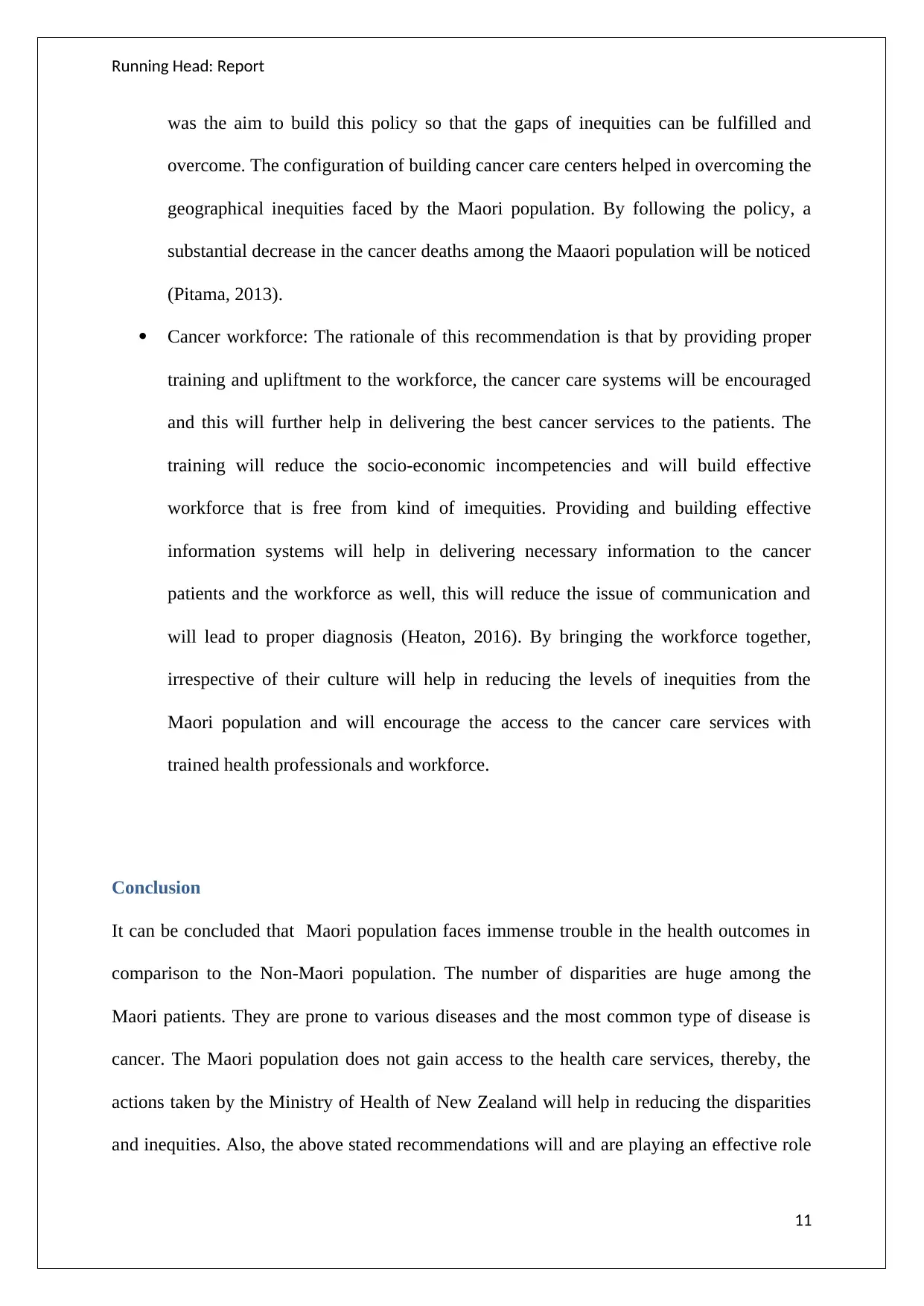
Running Head: Report
was the aim to build this policy so that the gaps of inequities can be fulfilled and
overcome. The configuration of building cancer care centers helped in overcoming the
geographical inequities faced by the Maori population. By following the policy, a
substantial decrease in the cancer deaths among the Maaori population will be noticed
(Pitama, 2013).
Cancer workforce: The rationale of this recommendation is that by providing proper
training and upliftment to the workforce, the cancer care systems will be encouraged
and this will further help in delivering the best cancer services to the patients. The
training will reduce the socio-economic incompetencies and will build effective
workforce that is free from kind of imequities. Providing and building effective
information systems will help in delivering necessary information to the cancer
patients and the workforce as well, this will reduce the issue of communication and
will lead to proper diagnosis (Heaton, 2016). By bringing the workforce together,
irrespective of their culture will help in reducing the levels of inequities from the
Maori population and will encourage the access to the cancer care services with
trained health professionals and workforce.
Conclusion
It can be concluded that Maori population faces immense trouble in the health outcomes in
comparison to the Non-Maori population. The number of disparities are huge among the
Maori patients. They are prone to various diseases and the most common type of disease is
cancer. The Maori population does not gain access to the health care services, thereby, the
actions taken by the Ministry of Health of New Zealand will help in reducing the disparities
and inequities. Also, the above stated recommendations will and are playing an effective role
11
was the aim to build this policy so that the gaps of inequities can be fulfilled and
overcome. The configuration of building cancer care centers helped in overcoming the
geographical inequities faced by the Maori population. By following the policy, a
substantial decrease in the cancer deaths among the Maaori population will be noticed
(Pitama, 2013).
Cancer workforce: The rationale of this recommendation is that by providing proper
training and upliftment to the workforce, the cancer care systems will be encouraged
and this will further help in delivering the best cancer services to the patients. The
training will reduce the socio-economic incompetencies and will build effective
workforce that is free from kind of imequities. Providing and building effective
information systems will help in delivering necessary information to the cancer
patients and the workforce as well, this will reduce the issue of communication and
will lead to proper diagnosis (Heaton, 2016). By bringing the workforce together,
irrespective of their culture will help in reducing the levels of inequities from the
Maori population and will encourage the access to the cancer care services with
trained health professionals and workforce.
Conclusion
It can be concluded that Maori population faces immense trouble in the health outcomes in
comparison to the Non-Maori population. The number of disparities are huge among the
Maori patients. They are prone to various diseases and the most common type of disease is
cancer. The Maori population does not gain access to the health care services, thereby, the
actions taken by the Ministry of Health of New Zealand will help in reducing the disparities
and inequities. Also, the above stated recommendations will and are playing an effective role
11
⊘ This is a preview!⊘
Do you want full access?
Subscribe today to unlock all pages.

Trusted by 1+ million students worldwide
1 out of 17
Related Documents
Your All-in-One AI-Powered Toolkit for Academic Success.
+13062052269
info@desklib.com
Available 24*7 on WhatsApp / Email
![[object Object]](/_next/static/media/star-bottom.7253800d.svg)
Unlock your academic potential
Copyright © 2020–2025 A2Z Services. All Rights Reserved. Developed and managed by ZUCOL.





